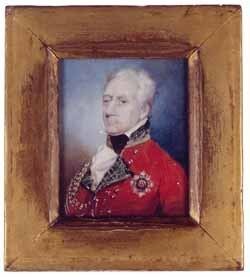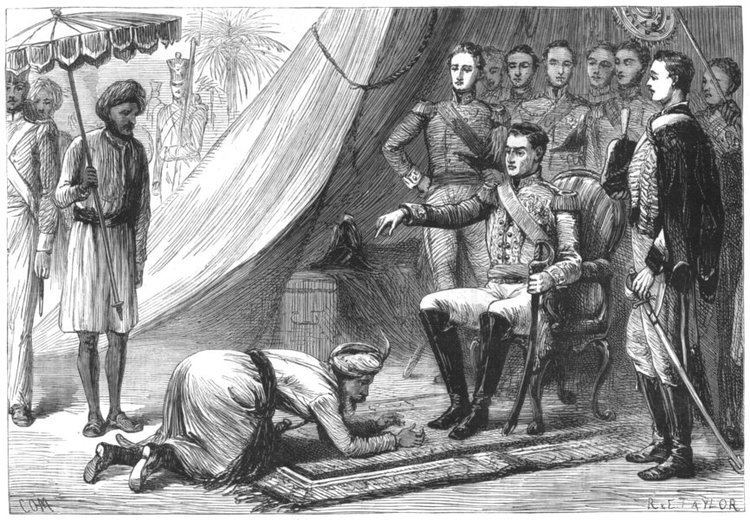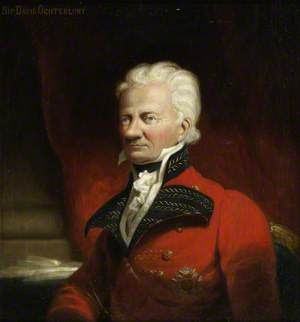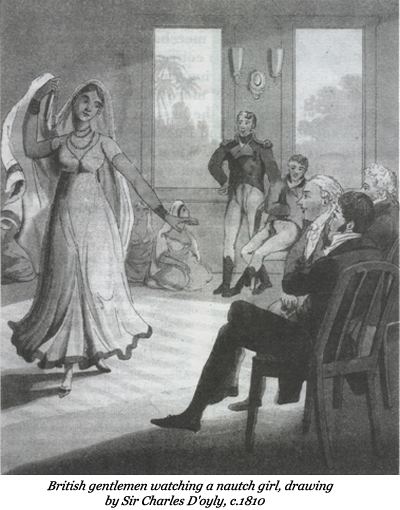Name David Ochterlony | ||
 | ||
Similar People Amar Singh Thapa, Bhimsen Thapa, Bhakti Thapa, Francis Rawdon‑Hastings - 1st Marqu, Balbhadra Kunwar | ||
Sir David Ochterlony, 1st Baronet of Pitforthy, 1st Baronet of Ochterlony GCB (12 February 1758 – 15 July 1825) was a Massachusetts-born general of the East India Company in British India. He held the powerful post of British Resident to the Mughal court at Delhi.
Contents

Biography

David Ochterlony was born in Boston, Massachusetts, the eldest son of Captain David Ochterlony (also Ochterloney) and his wife, Katherine Tyler. His father was born into an ancient family in Forfarshire, Scotland, and his mother was born in Boston to settlers of English and Welsh descent. His mother was the niece of Sir William Pepperrell. He had two younger brothers, Gilbert and Alexander, and a sister, Catherine. Captain Ochterlony died in the Saint Vincent, West Indies, in 1765, after which his widow moved back to England and his mother remarried to Sir Isaac Heard, Garter King-of-Arms. He attended the Boston Latin School and Dummer Charity School (now known as The Governor's Academy) in nearby Byfield, Massachusetts.

In 1777, at age 18, Ochterlony went as a cadet to India, where he served under Lord Lake in the battles of Koil, Aligarh and Delhi, and was appointed resident at Delhi in 1803. In 1804, having been promoted to the rank of major-general, he defended the city with a very inadequate force against an attack by Yashwantrao Holkar. On the outbreak of the Anglo-Nepalese War (1814–15) he was given the command of one of four converging columns, and his services were rewarded with a baronetcy created on 7 March 1816. Subsequently he was promoted to the command of the main force in its advance on Kathmandu, and outmanoeuvring the Gurkhas by a flank march at the Kourea Ghat Pass, brought the war to a successful conclusion and obtained the signature of the Treaty of Sugauli (1816), which dictated the subsequent relations of the British with Nepal. For this success Ochterlony was created Knight Grand Cross of the Order of the Bath, the first time that honour had been conferred on an officer of the British military in India.

In the Pindari War (1817–18) he was in command of the Rajputana column, made a separate agreement with Amir Khan, detaching him from the Pindaris, and then, interposing his own force between the two main divisions of the enemy, brought the war to an end without an engagement. He was appointed resident in Rajputana in 1818, with which the residency at Delhi was subsequently combined, and during this period encountered and engaged in an ongoing personal feud with James Tod, which was based most likely on the power politics within the hierarchy of the East India Company.
When Durjan Sal revolted in 1825 against Balwant Singh, the infant Raja of the Princely state of Bharatpur, Ochterlony acting on his own responsibility supported the raja by proclamation and ordered out a force to support him. However, the Governor-General of India, Lord Amherst, repudiated these proceedings. Ochterlony, who was bitterly chagrined by this rebuff, resigned his office, and retired to Delhi. The feeling that the confidence which his length of service merited had not been given him by the governor-general is said to have accelerated his death, which occurred at Meerut in 1825 where he is interred in St. John's Church. The Ochterlony column at Calcutta commemorates his name.
Private life
As the official British Resident at Delhi, David Ochterlony adopted and thoroughly embraced Persian Mughal culture. He was reputed to have thirteen Indian concubines (as seen by the British) or wives (as seen by others). Every evening, he used to take all thirteen of his wives on a promenade around the walls of the Red Fort, each on the back of her own elephant.
Moobaruck Begum
The most prominent among Ochterlony's women was Bebee Mahruttun Moobaruck ul Nissa Begum, a former Brahmin dancing girl from Poona who had converted to Islam. Nicknamed "Generallee Begum", she was Ochterlony's favorite and the mother of his youngest children. As such, she took clear precedence over the rest of the household. She was considered to be a devout Muslim, having once applied for leave to make the hajj to Mecca.
Although much younger than Ochterlony, Moobaruck was seen as the dominant personality in the relationship. This led one observer to remark that "making Sir David the Commissioner of Delhi was the same as making Generallee Begum". Another observer remarked that "Ochterlony's mistress is the mistress now of everyone within the walls. As a result of her influence, Ochterlony considered raising his children as Muslims, and when his two daughters by Moobaruck Begum had grown up, he adopted a child from the family of the Nawabs of Loharu, one of the leading Muslim families of Delhi. Raised by Moobaruck, the girl went on to marry her cousin, a nephew of the famous Urdu poet Mirza Ghalib.
Moobaruck even seems to have set herself up as a power in her own right and to have formed her own independent foreign policy. At one point, it was reported that "Mobarruck Begum, alias Generalee Begum, fills the [Delhi] papers with accounts of the Nizars and Khiluts [gifts and dresses of honour] given and taken by her in her transactions with the Vacquils [ambassadors of the different Indian powers] - an extraordinary liberty, if true."
However, in spite of all her power and high status, Moobaruck Begum was widely unpopular among the British and the Mughals alike. She offended the British by calling herself "Lady Ochterlony" and on the other hand, also offended the Mughals by awarding herself the title "Qudsia Begum", a title previously reserved for the Emperor's mother. After Ochterlony's death, she inherited Mubarak Bagh, an Anglo-Mughal garden tomb Ochterlony had built in the north of Old Delhi, but her intense unpopularity combined with her background as a dancing girl ensured that no Mughal gentleman would use her structure. To this date, the tomb is still referred to by the local inhabitants of the old city as the "Rundi ki Masjid" (the Whore's Mosque).
Descendants
Ochterlony had at least six natural children by two or more of his concubines:
- Roderick Peregrine Ochterlony, of Delhi (1785-d by 1823), only son; he married 1808 Sarah Nelly, the daughter of Lt. Col. John Nelly of the Bengal Engineers, at Allahabad, India. Roderick and Sarah Ochterlony had three children. A daughter Charlotte Ochterlony died in 1835 (death mentioned in The Gentleman's Magazine.
- Sir Charles Metcalfe Ochterlony, 2nd Baronet (1817–1891), who succeeded his grandfather by special remainder in 1825. He married 1844 a Miss Sarah Tribe of Liverpool, and had descendants three sons and two daughters. This creation became extinct on the death of the fifth Baronet in 1964.
- Charlotte Ochterlony (d. 1835)
- Sir Charles Metcalfe Ochterlony, 2nd Baronet (1817–1891), who succeeded his grandfather by special remainder in 1825. He married 1844 a Miss Sarah Tribe of Liverpool, and had descendants three sons and two daughters. This creation became extinct on the death of the fifth Baronet in 1964.
- [by Mubarak Begum] a daughter
- [by Mubarak Begum] a daughter
